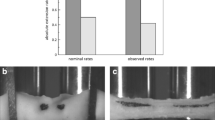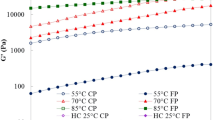Abstract
Strain hardening of wheat flour (WF) proteins during fermentation and baking is at the basis of the excellent quality of wheat breads. Yet, there are good reasons to use rye flour (RF), such as its high content of dietary fiber and other bioactives. However, rye proteins lack the ability to form dough with sufficient strain hardening capacity under extension, which partially explains the inferior quality of rye breads. A promising strategy to make high-quality breads with high nutritional value is the use of WF and RF blends. Despite this, the rheological behavior of WF/RF bread doughs has not yet been investigated. This study examines their rheology by non-linear uniaxial extensional and small-amplitude oscillatory shear measurements, and relates these measurements to the quality of the resulting breads. The strain hardening index (SHI), derived from extensional measurements, is expressed as the transient extensional viscosity at maximum strain [ηe+(εmax)] relative to the linear extensional viscosity extrapolated to maximum strain [ηe0+(εmax)]. Both the SHI and bread volume decreased when the level of RF in the blend increased. As an example, replacing 60% WF by RF led to a relative decrease of the SHI and bread volume of 34 and 64%, respectively. The decrease of the SHI is correlated to an increase in ηe0+(εmax). Comparison of the extensional curves of doughs made with blends of WF and RF and doughs made with blends of WF and wheat starch (WS) further revealed that RF components play a major role in the rheology of the doughs. In conclusion, it was found that WF/RF blends need to contain at least 60% WF to obtain bread of proper quality.









Similar content being viewed by others
References
AACC International. (2000). Approved methods of analysis. St. Paul: American Association of Cereal Chemists International.
Amemiya, J. I., & Menjivar, J. A. (1992). Comparison of small and large deformation measurements to characterize the rheology of wheat flour doughs. Journal of Food Engineering, 16(1–2), 91–108. https://doi.org/10.1016/0260-8774(92)90022-X.
Andersson, R., Fransson, G., Tietjen, M., & Aman, P. (2009). Content and molecular- weight distribution of dietary fiber components in whole-grain rye flour and bread. Journal of Agricultural and Food Chemistry, 57(5).
Angioloni, A., & Collar, C. (2011). Nutritional and functional added value of oat, Kamut ®, spelt, rye and buckwheat versus common wheat in breadmaking. Journal of the Science of Food and Agriculture, 91(7), 1283–1292. https://doi.org/10.1002/jsfa.4314.
AOAC International. (1995). Official methods of analysis of AOAC international. Washington: Association of Official Analytical Chemists International.
Arp, C. G., Correa, M. J., & Ferrero, C. (2018). Rheological and microstructural characterization of wheat dough formulated with high levels of resistant starch. Food and Bioprocess Technology, 11(6), 1149–1163. https://doi.org/10.1007/s11947-018-2083-8.
Beck, M., Jekle, M., Selmair, P. L., Koehler, P., & Becker, T. (2011). Rheological properties and baking performance of rye dough as affected by transglutaminase. Journal of Cereal Science, 54(1), 29–36. https://doi.org/10.1016/j.jcs.2011.01.012.
Bigne, F., Romero, A., Ferrero, C., Puppo, M. C., & Guerrero, A. (2017). Rheological and microstructural study of wheat doughs partially replaced with mesquite flour (Prosopis alba) and added with transglutaminase. Food and Bioprocess Technology, 10(5), 819–830. https://doi.org/10.1007/s11947-017-1869-4.
Buksa, K., Ziobro, R., Nowotna, A., & Gambuś, H. (2013). The influence of native and modified arabinoxylan preparations on baking properties of rye flour. Journal of Cereal Science, 58(1), 23–30. https://doi.org/10.1016/j.jcs.2013.04.007.
Bushuk, W. (2001). Rye production, chemistry and technology. St. Paul, MN: AACC Inc..
Courtin, C. M., & Delcour, J. A. (2002). Arabinoxylans and endoxylanases in wheat flour bread-making. Journal of Cereal Science, 35(3), 225–243. https://doi.org/10.1006/jcrs.2001.0433.
Courtin, C. M., Roelants, A., & Delcour, J. A. (1999). Fractionation-reconstitution experiments provide insight into the role of endoxylanases in bread-making. Journal of Agricultural and Food Chemistry, 47(5), 1870–1877.
Courtin, C. M., Van den Broeck, H., & Delcour, J. A. (2000). Determination of reducing end sugar residues in oligo- and polysaccharides by gas-liquid chromatography. Journal of Chromatography A, 866(1), 97–104.
Delcour, J. A., & Hoseney, R. C. (2010). Principles of cereal science and technology (3rd ed.). St. Paul, MN: AACC International.
Delcour, J. A., Vanhamel, S., & De Geest, C. (1989). Physico-chemical and functional properties of rye nonstarch polysaccharides. I. Colorimetric analysis of pentosans and their relative monosaccharide compositions in fractionated (milled) rye products. Cereal Chemistry, 66(2), 107–111.
Dewettinck, K., Van Bockstaele, F., Kühne, B., Van de Walle, D., Courtens, T. M., & Gellynck, X. (2008). Nutritional value of bread: Influence of processing, food interaction and consumer perception. Journal of Cereal Science, 48(2), 243–257. https://doi.org/10.1016/j.jcs.2008.01.003.
Dobraszczyk, B. J., Smewing, J., Albertini, M., Maesmans, G., & Schofield, J. D. (2003). Extensional rheology and stability of gas cell walls in bread doughs at elevated temperatures in relation to breadmaking performance. Cereal Chemistry, 80(2), 218–224. https://doi.org/10.1094/CCHEM.2003.80.2.218.
Dunnewind, B., Sliwinski, E. L., & Grolle, K. (2004). The Kieffer dough and gluten extensibility rig—an experimental evaluation. Journal of Texture Studies, 34, 537–560.
Fardet, A. (2010). New hypotheses for the health-protective mechanisms of whole-grain cereals: what is beyond fibre? Nutrition Research Reviews, 23(1), 65–134. https://doi.org/10.1017/S0954422410000041.
Field, J. M., Shewry, P. R., & Miflin, B. J. (1982). The purification and characterization of homologous high molecular weight storage proteins from grain of wheat, rye and barley. Theoretical and Applied Genetics, 65, 329–336.
Gabriele, D., De Cindio, B., & D’Antona, P. (2001). A weak gel model for foods. Rheologica Acta, 40(2), 120–127. https://doi.org/10.1007/s003970000139.
Gan, Z., Ellis, P. R., & Schofield, J. D. (1995). Mini review gas cell stabilisation and gas retention in wheat bread dough. Journal of Cereal Science, 21, 215–230.
Gellrich, C., Schieberle, P., & Wieser, H. (2003). Biochemical characterization and quantification of the storage protein (secalin) types in rye flour. Cereal Chemistry, 80(1), 102–109.
Gellrich, C., Schieberle, P., & Wieser, H. (2004). Biochemical characterization of γ-75k secalins of rye. II. Disulfide bonds. Cereal Chemistry, 81(2), 296–299. https://doi.org/10.1094/CCHEM.2004.81.2.296.
Goesaert, H., Brijs, K., Veraverbeke, W. S., Courtin, C. M., Gebruers, K., & Delcour, J. A. (2005). Wheat flour constituents: how they impact bread quality, and how to impact their functionality. Trends in Food Science and Technology, 16(1–3), 12–30. https://doi.org/10.1016/j.tifs.2004.02.011.
Gomand, S. V., Verwimp, T., Goesaert, H., & Delcour, J. A. (2011). Structural and physicochemical characterisation of rye starch. Carbohydrate Research, 346(17), 2727–2735. https://doi.org/10.1016/j.carres.2011.09.024.
Gómez, M., González, J., & Oliete, B. (2012). Effect of extruded wheat germ on dough rheology and bread quality. Food and Bioprocess Technology, 5(6), 2409–2418. https://doi.org/10.1007/s11947-011-0519-5.
Jonsson, K., Andersson, R., Bach Knudsen, K. E., Hallmans, G., Hanhineva, K., Katina, K., et al. (2018). Rye and health—where do we stand and where do we go? Trends in Food Science and Technology, 79, 78–87. https://doi.org/10.1016/j.tifs.2018.06.018.
Kipp, B., Belitz, H. D., Seilmeier, W., & Wieser, H. (1996). Comparative studies of high M(r) subunits of rye and wheat. 1. Isolation and biochemical characterisation and effects on gluten extensibility. Journal of Cereal Science, 23(3), 227–234. https://doi.org/10.1006/jcrs.1996.0023.
Kohler, P., & Wieser, H. (2000). Comparative studies of high M-r subunits of rye and wheat. III. Localisation of cysteine residues. Journal of Cereal Science, 32(2), 189–197. https://doi.org/10.1006/jcrs.2000.0324.
Laguna-Gutierrez, E., Van Hooghten, R., Moldenaers, P., & Rodriguez-Perez, M. A. (2015). Understanding the foamability and mechanical properties of foamed polypropylene blends by using extensional rheology. Journal of Applied Polymer Science, 132, 42430(1)–42430(14). https://doi.org/10.1002/app.42430.
Läuger, J., Wollny, K., & Huck, S. (2002). Direct strain oscillation: a new oscillatory method enabling measurements at very small shear stresses and strains. Rheologica Acta, 41(4), 356–361. https://doi.org/10.1007/s00397-002-0231-5.
Létang, C., Piau, M., & Verdier, C. (1999). Characterization of wheat flour-water doughs. Part I: rheometry and microstructure. Journal of Food Engineering, 41(2), 121–132. https://doi.org/10.1016/S0260-8774(99)00082-5.
McNaught, A. D., & Wilkinson, A. (1997). Compendium of chemical terminology. Oxford: Blackwell Scientific Publications.
Meerts, M. (2018). Assessing the role of the main flour components and fermentation in the rheology of wheat flour dough with a new rheological toolbox. KU Leuven.
Meerts, M., Cardinaels, R., Oosterlinck, F., Courtin, C. M., & Moldenaers, P. (2017a). The impact of water content and mixing time on the linear and non-linear rheology of wheat flour dough. Food Biophysics, 12(2), 151–163. https://doi.org/10.1007/s11483-017-9472-9.
Meerts, M., Cardinaels, R., Oosterlinck, F., Courtin, C. M., & Moldenaers, P. (2017b). The interplay between the main flour constituents in the rheological behaviour of wheat flour dough. Food and Bioprocess Technology, 10(2), 249–265. https://doi.org/10.1007/s11947-016-1810-2.
Meerts, M., Van Ammel, H., Meeus, Y., Van Engeland, S., Cardinaels, R., Oosterlinck, F., et al. (2017c). Enhancing the rheological performance of wheat flour dough with glucose oxidase, transglutaminase or supplementary gluten. Food and Bioprocess Technology, 10(12), 2188–2198. https://doi.org/10.1007/s11947-017-1986-0.
Mironeasa, S., Iuga, M., Zaharia, D., & Mironeasa, C. (2019). Rheological analysis of wheat flour dough as influenced by grape peels of different particle sizes and addition levels. Food and Bioprocess Technology, 12(2), 228–245. https://doi.org/10.1007/s11947-018-2202-6.
Osborne, T. B. (1907). The proteins of the wheat kernel. Washington, D.C.: Carnegie Institution of Washington. https://doi.org/10.1021/ja02106a003.
Park, S. H., Wilson, J. D., Chung, O. K., & Seib, P. A. (2004). Size distribution and properties of wheat starch granules in relation to crumb grain score of pup-loaf bread. Cereal Chemistry, 81(6), 699–704. https://doi.org/10.1094/CCHEM.2004.81.6.699.
Redant, L., Buggenhout, J., Brijs, K., & Delcour, J. A. (2017). Extractability and chromatographic separation of rye (Secale cereale L.) flour proteins. Journal of Cereal Science, 73, 68–75. https://doi.org/10.1016/j.jcs.2016.11.010.
Salinas, M. V., Carbas, B., Brites, C., & Puppo, M. C. (2015). Influence of different carob fruit flours (Ceratonia siliqua L.) on wheat dough performance and bread quality. Food and Bioprocess Technology, 8(7), 1561–1570. https://doi.org/10.1007/s11947-015-1527-7.
Sanchez, D. B. O., Puppo, M. C., Añon, M. C., Ribotta, P. D., León, A. E., & Tadini, C. C. (2014). Effect of maize resistant starch and transglutaminase: a study of fundamental and empirical rheology properties of pan bread dough. Food and Bioprocess Technology, 7(10), 2865–2876. https://doi.org/10.1007/s11947-013-1246-x.
Shogren, M. D., & Finney, K. F. (1984). Bread-making tests for 10 grams of flour. Cereal Chemistry, 61, 418–423.
Singh, J., & Singh, N. (2001). Studies on the morphological, thermal and rheological properties of starch separated from some Indian potato cultivars. Food Chemistry, 75(1), 67–77. https://doi.org/10.1016/S0308-8146(01)00189-3.
Sroan, B. S., Bean, S. R., & MacRitchie, F. (2009). Mechanism of gas cell stabilization in bread making. I. The primary gluten-starch matrix. Journal of Cereal Science, 49(1), 32–40. https://doi.org/10.1016/j.jcs.2008.07.003.
Steffe, J. F. (1996). Rheological methods in food process engineering (2nd ed.). Freeman Press Retrieved from http://linkinghub.elsevier.com/retrieve/pii/0260877494900906.
Tanner, R. I., Qi, F., Uthayakumaran, S., & Dai, S. C. (2013). The effect of pre-test deformation on dough rheology. Rheologica Acta, 52(1), 33–38. https://doi.org/10.1007/s00397-012-0665-3.
van Vliet, T. (2008). Strain hardening as an indicator of bread-making performance: a review with discussion. Journal of Cereal Science, 48(1), 1–9. https://doi.org/10.1016/j.jcs.2007.08.010.
Veraverbeke, W. S., & Delcour, J. A. (2002). Wheat protein composition and properties of wheat glutenin in relation to breadmaking functionality. Critical Reviews in Food Science and Nutrition, 42(3), 179–208. https://doi.org/10.1080/10408690290825510.
Verwimp, T., Vandeputte, G. E., Marrant, K., & Delcour, J. A. (2004). Isolation and characterisation of rye starch. Journal of Cereal Science, 39(1), 85–90. https://doi.org/10.1016/S0733-5210(03)00068-7.
Verwimp, T. (2007). Isolation, characterization and structural features of rye flour starch and non-starch polysaccharide constituents. K.U. Leuven.
Vinkx, C. J. A., & Delcour, J. A. (1996). Rye (Secale cereale L.) arabinoxylans: a critical review. Journal of Cereal Science, 24, 1–14.
Acknowledgments
Frederik Janssen and Arno G.B. Wouters gratefully acknowledge the Research Foundation-Flanders (FWO-Vlaanderen, Brussels, Belgium) for positions as doctoral (FJ) and postdoctoral (AW) researchers. Jan A. Delcour is W.K. Kellogg Chair in Cereal Science and Nutrition at KU Leuven.
Author information
Authors and Affiliations
Corresponding author
Additional information
Publisher’s Note
Springer Nature remains neutral with regard to jurisdictional claims in published maps and institutional affiliations.
Rights and permissions
About this article
Cite this article
Meeus, Y., Janssen, F., Wouters, A.G.B. et al. Linear and Non-linear Rheology of Bread Doughs Made from Blends of Wheat (Triticum aestivum L.) and Rye (Secale cereale L.) Flour. Food Bioprocess Technol 13, 159–171 (2020). https://doi.org/10.1007/s11947-019-02393-w
Received:
Accepted:
Published:
Issue Date:
DOI: https://doi.org/10.1007/s11947-019-02393-w




